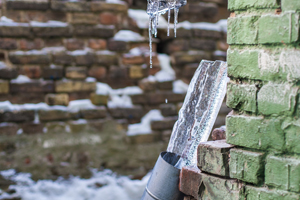Dallas Plumbers • Dealing with Frozen Pipes
 Now that colder weather is here, the potential for frozen pipes is a headache homeowners want to avoid. Unfortunately, too many people are under the mistaken assumption that, since Dallas doesn’t typically experience frigid temperatures, frozen pipes aren’t a problem. In reality, with blasts of cold artic air that can reach the Dallas metro area, a few days of freezing weather can result in frozen pipes link to www.wikihow.com/Unfreeze-Water-Pipes under homes or in basements. Once pipes freeze, water will not flow to your shower, sink, or appliances. In some cases, pipes can burst, causing thousands of dollars in damage.
Now that colder weather is here, the potential for frozen pipes is a headache homeowners want to avoid. Unfortunately, too many people are under the mistaken assumption that, since Dallas doesn’t typically experience frigid temperatures, frozen pipes aren’t a problem. In reality, with blasts of cold artic air that can reach the Dallas metro area, a few days of freezing weather can result in frozen pipes link to www.wikihow.com/Unfreeze-Water-Pipes under homes or in basements. Once pipes freeze, water will not flow to your shower, sink, or appliances. In some cases, pipes can burst, causing thousands of dollars in damage.
Identifying Pipes that are frozen
If your faucets aren’t working and you have good reason to believe your pipes are frozen, you may be able to thaw them using any number of different techniques. First, turn on any faucets that are blocked. Next, try to determine which pipe is frozen. You can do this by inspecting your pipes in crawlspaces, the basement, or any areas where plumbing is exposed, looking for evidence of freezing. Touching pipes can also indicate if they are frozen.
If your pipes leak around the joints you’ll see frozen water. In other cases, you may notice a water line coated in frost link to www.houselogic.com/home-advice/plumbing/freezing-water-pipes/. If you have different pipes that carry water from the main, feeling them can also indicate which one is frozen: if one is noticeably colder than the others, this is a good indication that the colder pipe is the frozen one.
Methods for Thawing Frozen Pipes
First, NEVER use a propane torch to thaw pipes. And, if a pipe bursts while you are trying to thaw it, turn off the water to your home immediately and call a plumber.
In order to prevent a frozen pipe from bursting, it’s best to use a method that won’t thaw a pipe too quickly. When thawed too quickly, the ice inside a pipe will turn into steam, creating more pressure that can lead to a burst pipe. Consequently, it’s best to use a method that initiates an even, slower process of thawing. In order to do this, it’s best to use a hair dryer, setting it on high and moving it back and forth a slow, uniform manner.
You can also soak towels in hot water and wrap them around frozen pipes. You’ll need to soak and reapply your hot towels about every 5 to 10 minutes until the pipe is thawed. This method may be particularly effective in areas where the use of a hairdryer is not convenient. If you have heat tape, the same method can be used, though you’ll need an outlet nearby to plug in the heat tape.
If you have frozen pipes behind your walls, it’s best to turn up the heat in your home to between 75 and 80 degrees for roughly two to three hours. Once you see water beginning to drip out of your faucets, you’ll know your pipes are beginning to thaw.
Contact Public Service Plumbers
Frozen pipes can lead to costly water damage and repairs. If you have a problem with frozen pipes, identifying a long-term solution is the best way to protect yourself from unwanted water damage. To learn how we can help you avoid potential problems associated with frozen pipes, call Public Service Plumbers at (214) 753-4633 or email us.






